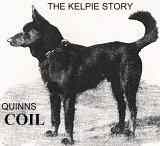
THE KELPIE
STORY
By Stephen & Mary Bilson
EARLY SHEEPDOG TRIALS
There is not a lot of information on
early sheepdog trials but historical research is always being
conducted by a number of interested people around Australia. Apart
from the 1871 and 1872 trial at Burrangong near Young in NSW, we know
there were some very early trials in the Moree area of NSW as well,
probably in 1874.
We also know that Sheepdog Trials were
held in New Zealand even earlier. The first trials held there were in
1867. There was another in 1868 and at least two separate ones in
1869.
July 9th 1869 edition of the Oamaru
Times, a New Zealand newspaper lists a report on a sheepdog trial
that was held over the weekend of June 22-23 as being the 3rd annual
trial. Three sheep were turned out and driven half a mile from the
handler in a circle. Another 3 sheep were driven in the opposite
direction and left a quarter of a mile from the first mob. The dog
then gets the first mob and brings them in and returns and picks up
the 2nd mob. The sheep are then joined together and yarded. The time
to complete the trial was 35 minutes.
Another New Zealand trial was held in
1868 at Gibsons Run (now Waitangi and Te Aka). On January 3rd 1869,
another trial was held on Black Forrest Run, Mackenzie country.
Reported in the Timaru Herald Feb 3rd 1869. Three sheep were put into
3 separate pens in 30 minutes. 10 dogs were entered.
So both these countries (Australia &
New Zealand) held trials earlier than 1873 which was when the first
trial was held in Bala, Wales and often reported as the first
sheepdog trial in the world. They even have a large monument there to
record the event.
 For many years the big
sheepdog trial at Forbes in NSW has been quoted as Australia's first
sheepdog trial and thought to have been as early as 1870 but it was
actually held in 1879. We now know from records that there were at
least a few sheepdog trials in Australia before this time. The Forbes
trial, however, caught the imagination of the public and the dogs
that attended became very well known and sought after.
For many years the big
sheepdog trial at Forbes in NSW has been quoted as Australia's first
sheepdog trial and thought to have been as early as 1870 but it was
actually held in 1879. We now know from records that there were at
least a few sheepdog trials in Australia before this time. The Forbes
trial, however, caught the imagination of the public and the dogs
that attended became very well known and sought after.
The first Sheepdog Trials in Australia
were a very simple affair and often consisted of a large pen 27 feet
long and 9 feet wide and the handler had to command his dog to work
three sheep into the pen without the handler coming within 100 yards
of the pen. By 1897, the sheep had to be worked through two gaps
(hurdles), 4.5 feet apart and then into a yard with a time limit of
10 minutes.
By 1901, the dogs had to work their sheep
through the very difficult Maltese Cross as well as a gap and the
pen. In 1903, the sheep had to be taken around three flags, a gap,
the maltese cross in two different directions and then to a pen.
Handlers often helped their dogs at obstacles. This is not allowed in
Australian trials today.
In 1904, the Maltese Cross and the
hurdles for the gap were replaced by a Race and a Bridge obstacle.
Because of the difficulty of the Maltese Cross, very few competitors
were able to complete the trial. In most if not all, of these early
trials a dog crossing between the handler and the sheep was allowed.
Today it is an instant disqualification.
By the early 1900's entries into the
Sheepdog Trials were around 40. Up until 1909, Sheepdog Trials were
judged by at least two men. After John Quinn complained at the Sydney
Trials that the judges continually argued he was made the sole judge
at the Sydney Trials and this gradually became the standard way of
judging.
______________________
Mr. Walter Beilby in his book, The Dog in
Australia, 1897. -"No breed of dog is
so extensively used in these colonies as the one under notice, and
none is more necessary. The Collie was one of the first of the canine
race introduced by the early settler, long before the goldfield were
discovered. A strain known as the Kelpie, that came from the island
colony, (Tasmania), are still plentiful in many parts of the Riverina
and Queensland."
If you have any additional information,
we'd love to hear from you
Mary and Stephen Bilson  Noonbarra Kelpie
Stud
Noonbarra Kelpie
Stud
P.O. Box 1374, Orange NSW,
Australia
Email:
kelpiestory@noonbarra.com
www.noonbarra.com
More information can be found in
the new 2006 edition our
book
'FAMOUS
KELPIES'



May 1999 -

 For many years the big
sheepdog trial at Forbes in NSW has been quoted as Australia's first
sheepdog trial and thought to have been as early as 1870 but it was
actually held in 1879. We now know from records that there were at
least a few sheepdog trials in Australia before this time. The Forbes
trial, however, caught the imagination of the public and the dogs
that attended became very well known and sought after.
For many years the big
sheepdog trial at Forbes in NSW has been quoted as Australia's first
sheepdog trial and thought to have been as early as 1870 but it was
actually held in 1879. We now know from records that there were at
least a few sheepdog trials in Australia before this time. The Forbes
trial, however, caught the imagination of the public and the dogs
that attended became very well known and sought after.

